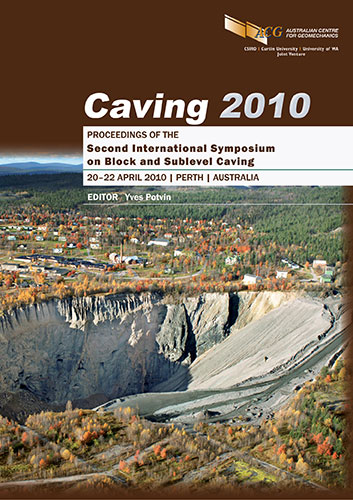Geomechanical evaluation of macro-block caving options using 3D numerical modelling at Chuquicamata underground project in Chile

|
Authors: Hormazabal, E; Villegas, F; Rovira, F; Carranza-Torres, C |
DOI https://doi.org/10.36487/ACG_rep/1002_32_Hormazabal
Cite As:
Hormazabal, E, Villegas, F, Rovira, F & Carranza-Torres, C 2010, 'Geomechanical evaluation of macro-block caving options using 3D numerical modelling at Chuquicamata underground project in Chile', in Y Potvin (ed.), Caving 2010: Proceedings of the Second International Symposium on Block and Sublevel Caving, Australian Centre for Geomechanics, Perth, pp. 469-482, https://doi.org/10.36487/ACG_rep/1002_32_Hormazabal
Abstract:
The Chuquicamata underground project in the Atacama Desert in northern Chile is one of the largest planned mining projects in the world to use the block caving method with macro-blocks options, to mine copper ore. VCP-Codelco (Vice-President Office of the National Copper Corporation of Chile) is currently completing a prefeasibility engineering study of this project, which considers the construction and operation of at least two macro-block mining units to be managed independently from each other. A geomechanical study has been carried out to analyse various options regarding to pillar sizes and mining sequences for the macro-blocks caving configurations considered for the project. As part of this study, complex 3D continuum models have been developed to assess the effects of the above options on the mechanical response of the underground openings, with emphasis in stress concentration in certain critical areas of the excavations such as macro-blocks pillars and rib-pillars. Relevant geological features such as major faults and lithological units were also considered in the models. This paper describes the main aspects of the Chuquicamata underground project by focusing on the 3D numerical models that were performed to evaluate the macro-block extraction options for this block cave.
References:
Codelco (2007) Geología y Recursos Minerales para la Ingeniería Conceptual del Proyecto Chuquicamata Subterráneo, Subgerencia de Geología, Dirección de Geología de Desarrollo, División Codelco Norte, Codelco, Chile.
VCP-Codelco (2009) Estudio de Prefactibilidad Proyecto Chuquicamata Subterráneo API N07DM43, VCP, Codelco, Chile.
Hoek, E. (1994) Strength of rock and rock masses, ISRM News Journal, Vol. 2(2), pp. 4–16.
Hoek, E., Carranza-Torres, C. and Corkum, B. (2002) Hoek–Brown Failure Criterion, 2002 Edition, in Proceedings 5th North American Rock Mechanics Symposium and 17th Tunneling Association of Canada Conference,
R. Hammah, W. Bawden, J. Curran and M. Telesnicki (eds), University of Toronto Press, Toronto, Vol. 1, pp. 267–273.
HCItasca–SRK (2006) Complementary Geotechnical Studies for Conceptual Design of an Underground Mine at Chuquicamata, HCItasca–SRK, Vancouver, Canada.
Karzulovic, A. (2007) Revisión Caracterización Geológico Geotécnico Proyecto Mina Chuquicamata Subterránea, PMCHS MSC-ICO-AKL-2000-GEM-INF-001-REV P, A. Karzulovic and Asoc. Ltda., Chile.
Laubscher, D.H. (1990) A Geomechanics Classification System for the Rating of Rock Mass in Mine Design, Journal of South African Institute of Mining and Metallurgy, Vol. 90(10).
SRK Consulting Ltda. (2009) Trabajos Geomecánicos Complementarios Proyecto Chuquicamata Subterráneo, Technical report MSC-ICO-SRK-2000-GTE-INF-002-Rev P, SRK Consulting Ltda. Santiago, Chile.
SRK Consulting Ltda. (2008) Evaluación Geomecánica de la Malla de Extracción Proyecto Mina Chuquicamata Subterránea, Technical report MSC-ICO-SRK- 2000-GTE-INF-001-Rev P, Santiago, Chile.
© Copyright 2025, Australian Centre for Geomechanics (ACG), The University of Western Australia. All rights reserved.
View copyright/legal information
Please direct any queries or error reports to repository-acg@uwa.edu.au
View copyright/legal information
Please direct any queries or error reports to repository-acg@uwa.edu.au